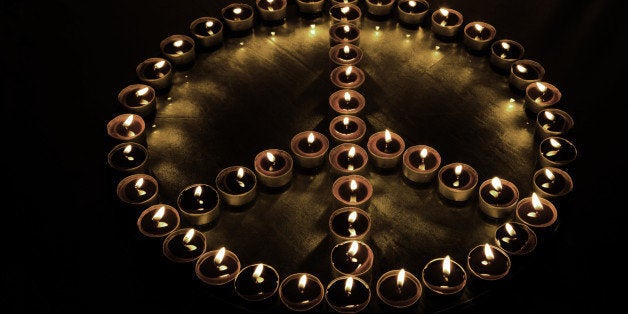
When I first tell people that I teach Peace Studies and Conflict Resolution, they tilt their heads to the side and say, "Peace...studies...?" (Sometimes they say "Peas...?") While the peace studies part confuses them, they recognize "conflict resolution" but assign that to the business world: "Oh, you teach people how to negotiate business deals." Not quite.
This response to my professional status means there is some confusion as to what it means to study "peace." More fundamentally, this response shows a lack of understanding about what "peace" actually is.
In "Nonviolence: more than the absence of violence" from Handbook of Peace and Conflict Studies, Jorgen Johansen notes a simple yet significant problem when approaching the subject of peace: peace does not receive a lot of attention, violence does. Violence gets noticed, it leads the news, it makes people talk. Peace is boring. It isn't sexy and sexy sells.
Part of this lack of attention towards peace comes because of the difficulty of defining peace. We all know violence and its reality, but peace...well, peace seems too perfect and perhaps too impossible to reach. Despite this idea of peace as perfection, we have general knowledge of what "peace" is because we use the term in everyday language, for example, when we mention "peace of mind" or needing "peace and quiet." These phrases tell us that peace is a state in which we have calmness and balance, a state in which we exist away from conflict or disruption. Having "peace of mind" or "peace and quiet" communicates assurance, stability, and quiet plus something more.
How might we discuss this concept that seems perfect and impossible, yet is sought out and desired?
In his introduction to the Handbook of Peace and Conflict Studies, Charles Webel notes that we often recognize peace through absence (5), suggesting that peace is best defined in the negative. Peace is not war. Peace is not violence. Peace is not terror and struggle. Peace is not physical and mental stress. We discuss peace in the same way theologians use negative theology to refer to God. God is not human, not limited by time or space, etc.
While we know when we do not have "peace of mind" and/or "peace and quiet," we are also aware of when we need "peace of mind" and "peace and quiet." We recognize when we have been able to capture "peace of mind" or a few moments of "peace and quiet," mostly because we know when that peace ends. Knowledge of peace through its absence tells us that peace has a fragile character and is vulnerable to disruption, which implies that peace requires protection and nurturing. That peace can be broken also indicates something about our ability to maintain it. Perhaps we are the fragile ones, vulnerable to distractions and stresses that introduce conflict and tension.
Because peace is something discussed in the negative (versus something we see and touch daily), we can infer that peace is not a thing or object to possess. I cannot purchase peace at a store, draw or photograph peace, bring peace to the movies, introduce peace to my family, put peace in a jar and display it. Peace is a state or a concept, a force beyond us that we cannot taste, touch, or smell. We can feel the energy of peace when it is engaged, and feel its lack when it is not activated. While this invisibility factor sounds bad, it is actually great news. If peace is a state of being or a concept that exists everywhere and always, that means peace is always available to us.
That we discuss peace in the negative and accept that peace is not a thing may make it easier to categorize peace as something that happens to us. We cannot see it, so we should just wait for it to tap us on the shoulder and say, "I'm here!" This expectation implies passivity and leads to a general misperception that we do not have to do anything to create peace. This belief of peace as passive removes all accountability and makes peace something for which humanity bears no responsibility. Waiting for peace to passively manifest and happen without assistance further lends itself to a view of peace as impossible to achieve. However, once we realize that peace happens with our participation, we can make creating peace actionable.
Because the ever-ready force that is peace surrounds us, peace is always available to and for us. To make peace happen, we have to tap into its force, and activate it in our lives. That is, we must choose to become engaged in peace. The notion that peace requires engagement and activation (i.e., it is something we do, not something done to or for us) means that the problem of living peacefully is ours, not peace's. If we do not have peace, and we claim to want it, the fault lies in our inability or refusal to act in a peaceful manner. We are responsible for our own behaviors, thoughts, and treatment of others. To be peaceful, to act in peace, to create and build peace is a choice. We choose every day whether we will respond to a person or event with peace or conflict.
When our view of peace shifts from passive to active, our understanding of peace's attainability changes. We can actively create peace each day. Peace cannot manifest through what I call the "kitchen table effect." You cannot sit around your kitchen table alone or with others, say you want peace, and then expect it to happen because you wish for it. You can sit at your kitchen table, discuss how you want peace, and then get up, leave your home, and make conscious decisions throughout your day that create peace in your life (and in the lives of others). We can manifest peace by living with intentionality: selecting responses to a situation and choosing to act in and with peace every single day.